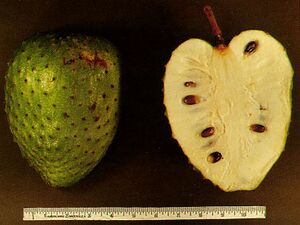Soursop: Difference between revisions
(Unbork utf8 errors) |
No edit summary |
||
| Line 3: | Line 3: | ||
|title=Soursop: Cooking Wiki | |title=Soursop: Cooking Wiki | ||
|titlemode=replace | |titlemode=replace | ||
|keywords= | |keywords=#soursop #citrus #cherimoya #pawpaw #fruit #pineapple #strawberry #banana #coconut | ||
|hashtagrev=12032020 | |||
|description=The soursop (Spanish guanabana, Portuguese graviola is a broadleaf flowering evergreen tree native to Mexico, Central America, the | |description=The soursop (Spanish guanabana, Portuguese graviola is a broadleaf flowering evergreen tree native to Mexico, Central America, the | ||
}} | }} | ||
<!-- /seo --> | |||
[[Image:{{PAGENAME}}.jpg|300px|thumb|right|Soursop]] | [[Image:{{PAGENAME}}.jpg|300px|thumb|right|Soursop]] | ||
The '''soursop''' (Spanish '''guanábana''', Portuguese '''graviola''' is a broadleaf flowering evergreen tree native to Mexico, Central America, the Caribbean and northern South America. Today, it is also grown in some areas of Southeast Asia. It is in the same genus as the [[cherimoya]] and the same family as the [[pawpaw]]. In most Spanish speaking countries it is commonly known as ''' | The '''soursop''' (Spanish '''guanábana''', Portuguese '''graviola''' is a broadleaf flowering evergreen tree native to Mexico, Central America, the Caribbean and northern South America. Today, it is also grown in some areas of Southeast Asia. It is in the same genus as the [[cherimoya]] and the same family as the [[pawpaw]]. In most Spanish speaking countries it is commonly known as '''Guanábana'''. In the Philippines, it is known as '''guyabano'''. | ||
The '''soursop''' is adapted to areas of high humidity and relatively warm winters, temperatures below 5 °C will cause damage to leaves and small branches, and temperatures below 3 °C can be fatal. | The '''soursop''' is adapted to areas of high humidity and relatively warm winters, temperatures below 5 °C will cause damage to leaves and small branches, and temperatures below 3 °C can be fatal. | ||
| Line 21: | Line 20: | ||
[[Category:Ingredients]] | [[Category:Ingredients]] | ||
[[Category:Fruit]] | [[Category:Fruit]] | ||
<!-- footer hashtags --><code 'hashtagrev:12032020'>[[Special:Search/soursop|#soursop]] [[Special:Search/citrus|#citrus]] [[Special:Search/cherimoya|#cherimoya]] [[Special:Search/pawpaw|#pawpaw]] [[Special:Search/fruit|#fruit]] [[Special:Search/pineapple|#pineapple]] [[Special:Search/strawberry|#strawberry]] [[Special:Search/banana|#banana]] [[Special:Search/coconut|#coconut]] | |||
</code><!-- /footer hashtags --> | |||
Latest revision as of 15:56, 2 February 2017

The soursop (Spanish guanábana, Portuguese graviola is a broadleaf flowering evergreen tree native to Mexico, Central America, the Caribbean and northern South America. Today, it is also grown in some areas of Southeast Asia. It is in the same genus as the cherimoya and the same family as the pawpaw. In most Spanish speaking countries it is commonly known as Guanábana. In the Philippines, it is known as guyabano.
The soursop is adapted to areas of high humidity and relatively warm winters, temperatures below 5 °C will cause damage to leaves and small branches, and temperatures below 3 °C can be fatal.
Comparisons of its flavour range from strawberry and pineapple mixed together to sour citrus flavour notes contrasting with an underlying creamy roundness of flavour reminiscent of coconut or banana. The fruit is somewhat difficult to eat, as the white interior pulp is studded with many large seeds, and pockets of soft flesh are bounded by fibrous membranes. The soursop is therefore usually juiced rather than eaten directly.
Find recipes that contain 'Soursop'
#soursop #citrus #cherimoya #pawpaw #fruit #pineapple #strawberry #banana #coconut